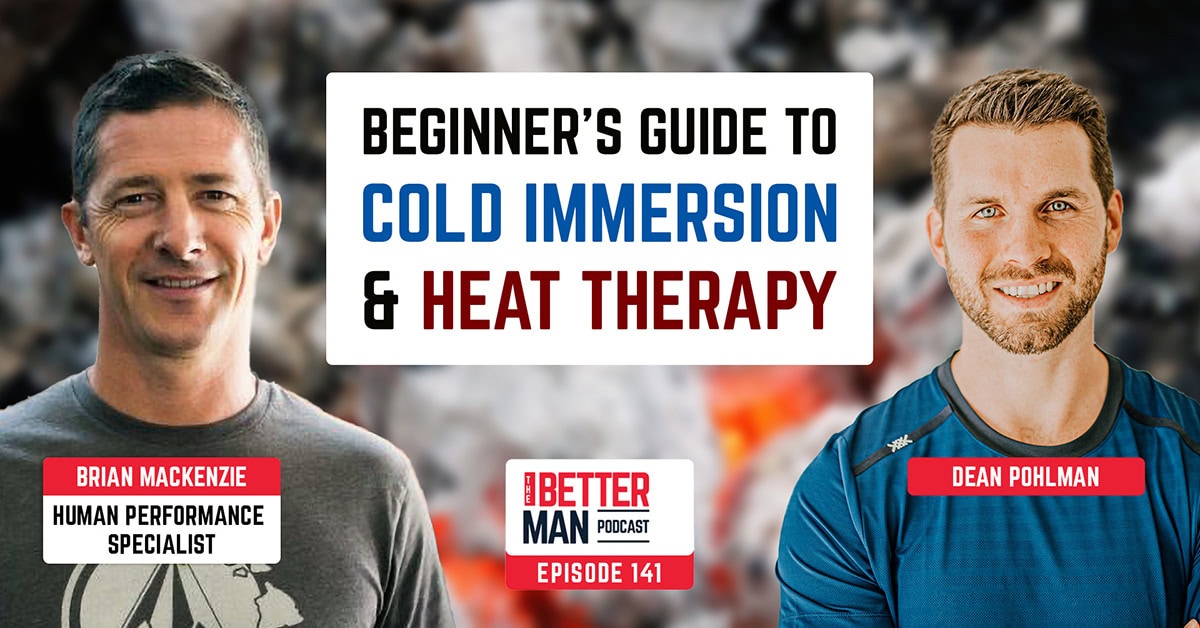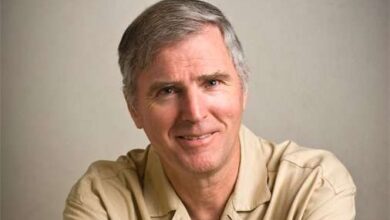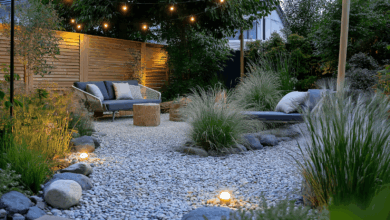Beginner’s Guide to Cold Immersion & Heat Therapy | Brian Mackenzie (Human Performance Specialist)
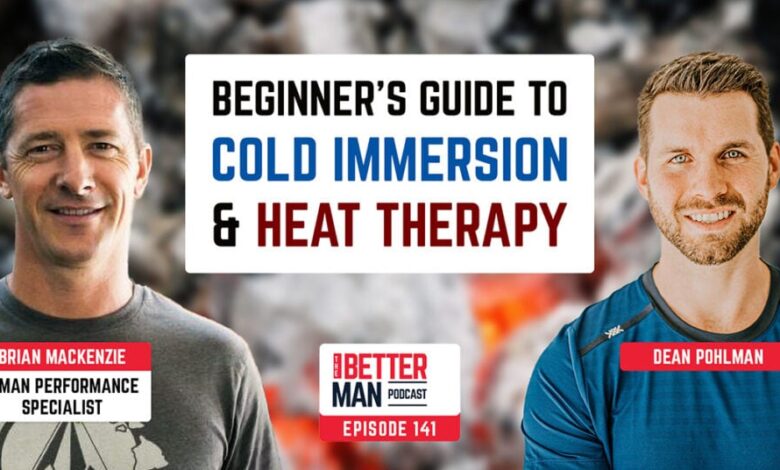
Figuring out which alternative therapies to fit into your already busy day, if any at all, can be overwhelming and confusing. Especially when marketing claims overexaggerate the benefits of alternative therapies and biohacking tools.
That’s why I invited human performance specialist, Brian Mackenzie, back onto the show to help make sense of two strategies that are exploding in popularity:
Cold immersion & heat therapy.
While both benefit the human body, you only have a limited amount of time each day.
So, which one should you pick, if any at all?
In today’s episode, Brian gives you the beginner’s guide to cold immersion and heat therapy, answers which therapy is superior for your body, and reminds you that fundamental things like sleep and movement are always more important than weird biohacks.
Brian also shares:
- How both cold immersion & heat therapy benefit the body (and which one is superior if you’re crunched on time)
- Why it’s easy to “dip your toes” into cold immersion & heat therapy without buying any external stuff
- Why you should never use ice to heal an injury
Listen now!
The Better Man Podcast is an exploration of our health and well-being outside of our physical fitness, exploring and redefining what it means to be better as a man; being the best version of ourselves we can be, while adopting a more comprehensive understanding of our total health and wellness. I hope it inspires you to be better!
Use the RSS link to find the Better Man Podcast on other apps: http://feeds.libsyn.com/404744/rss
Episode 141 Highlights
- Why a human performance specialist doesn’t recommend cold plunging to most people who already work out (2:34)
- How ice actually inhibits the natural healing process, not accelerates it (this means that the RICE method to healing an injury is outdated too) (4:28)
- How to start practicing cold immersion without buying a giant cold plunging tub or traveling anywhere other than your shower (14:22)
- Why sleep quality is the anabolic steroid of non-anabolic steroid use (and how cold immersion helps with sleep more than any other benefit) (17:20)
- What’s more beneficial to the human body: Cold immersion or heat therapy? A human performance specialist answers here (31:53)
- The weird way heat therapy mimics altitude training inside your body (33:27)
- The best time to hop in a sauna to get the maximum performance benefits for your body (37:09)
- Why movement is the most effective medicine for the healing process (and here’s what that means in the context of rolling your ankle) (47:47)
- Why the Marc Pro Electrical Muscle Stimulator plays a crucial role in recovering from a hip surgery (49:28)
Resources mentioned on this episode:
- Your breath is the best indicator of how well you handle stress. By handling your stress better, everything becomes easier and conquerable. If you want to improve your breathing, go to Brian’s website here: https://shiftadapt.com
Dean Pohlman: Hey guys, it’s Dean. Welcome back to the Better Man podcast. Today’s episode is an interview featuring Bryan McKenzie. Bryan is a human performance specialist. He has authored three books. He has been in the exercise science game for decades and decades now. He is extremely knowledgeable about all things exercise related. He specializes in endurance training. He’s a former Iron Man himself.
Dean Pohlman: And all of these things that people are seeing now in Exercise World, like cold, plunging sauna recovery. Bryan has been doing this stuff since before it was cool. He pioneered the research on this stuff so I’m really excited to bring him on to the podcast today. He’s been a guest in the past. He’s also featured in my book, yoga for athletes.
Dean Pohlman: So, he’s been awesome. And, just helping with mental yoga. And today’s conversation, we’re going to talk about all things that you might have questions with, with cold plunging and with sauna. We’re going to talk about how it can be effective, whether the heat or the cold is more effective. We’re also going to get into a few other topics in the recovery and exercise world.
Dean Pohlman: And remember, all of this is done with the goal of how does this make us more resilient? How does this make it stronger? How does this help with our health? And, Brian does an awesome job explaining this. So I really hope you guys enjoyed this interview. And, I’ll see you at the end. Hey guys, it’s Dean, and welcome to the Better Man podcast.
Dean Pohlman: I’ve got Brian Mackenzie back again to help me understand exercise science. So thank you.
Brian Mackenzie: You’re welcome. So the practical application of exercise science.
Dean Pohlman: Yes. And specifically here I want to talk today about cold water immersion and sauna. So from a from a from an everyday wellness perspective for someone who is not training to be, you know, in the MLB who is into training to win the Ironman competition or set enormous records, but just wants to build strength, wants to live a long, healthy life where they are as independent for as long as possible and they feel good in their bodies.
Dean Pohlman: Why is cold plunging? Why is sauna? Why? Why should we care about any of this? And I’ll just. I’ll turn it over to you and I’ll. I’ll jump in when I, when I want more clarity on something.
Brian Mackenzie: Well, I’ll start with the cold. I don’t actually feel like cold. Is that necessary? Especially for people who are training already. A lot, or enough. Right. And have day jobs and kids. And and here’s why.
Brian Mackenzie: You can only do so much in a day. And the cold is going to be an added stressor. And although it’s in although it’s effective at creating a calmer effect due to the neuro chemical reactions etc., that we that most people understand by now with the dopamine, etc. you’re probably getting enough of that through the exercise you’re doing now.
Brian Mackenzie: That doesn’t mean you couldn’t be getting a brief dose in the morning, but if I’m saying that to people who also work, I’m betting most of those people are actually exercising the morning. So now you’re talking about, I’m going to wake up, I’m going to do some cold plunge, then I’m going to go work out. And so I’m getting this but, but, but but what’s the stimulus that I’m going to go work?
Brian Mackenzie: I would say if, if you want to give cold an opportunity, you’re probably best doing it with inside the shower when you’re taking a shower. Right. And then, hey, hit it with the cold as you get in the shower if you’ve just done something, you know, cardio wise. So I’ll just I’ll slow down a second where it’s like shower time.
Brian Mackenzie: Could be that time, right? However, we want to think of the. And this is also why I’m like the cold isn’t really as important. So if we go back in time, there’s this old adage, and you’ll probably remember this, and your wife for sure, because she’s right. So. Right. Rest. Ice compression of elevation. The ice portion has been was rescinded by the exact doc who created the actual thing, who created this idea of healing due to the fact that there was there was mounting evidence showing ice was inhibiting the actual healing process of what was going on.
Brian Mackenzie: Although there were plenty of people there. And, you know, Mark Pro, the, the kind of big souped up tens unit that I many people like, Kelly star jumped on with very early on when they became a company, were screaming about this and saying, no, ice is not doing what you think, right. Well, so take a step back to what we were just talking about now.
Brian Mackenzie: Right. Or or step forward in time. So we know that ice inhibits the recovery phase of an injury or the healing phase of something. If I’m doing any sort of exercise that requires healing.
Brian Mackenzie: That cold can inhibit that actual exercise that we were the thing we were actually attempting to like create an adaptation to. Right. So we not, we’re not interrupting something. But here’s the interesting part. You could still do some cold in the shower or even in a cold plunge. It’s just low short dose like less than 30s. Right.
Brian Mackenzie: So that way you’re not getting everything to cold to constrict and then you’re warming things back up. So then you’re actually getting this. So you could fluctuate something like, hey, I’m going to do cold shower or cold plunge for like 30s. Then I’m going to do hot shower. You’re best doing hot water or something like that. Versus sauna because that’s going to take more time.
Brian Mackenzie: However, it’s, it can be as simple as like you’re going to your body warms back up after less than 30s of cold, which if you’re cold, adapted, that’s a fairly easy that’s a fairly easy thing to do in most climates. Outside of being in, you know, subfreezing temperatures. Right? Yeah. So meaning I could go in and probably take a 32nd cold shower, or I could go jump in my cold plunge in the backyard for 30s after I did some sort of strengthening conditioning, which would require healing.
Brian Mackenzie: And then I probably, I’m most likely not inhibiting anything. So long as I’m body back, my body warms back up. That’s what’s really important to understand. Now, if I’m doing Arabic training, that doesn’t necessitate, healing phase, which is more just about being catabolic in nature, and we’re really just doing some cardio. The cold is perfectly fine afterwards.
Brian Mackenzie: Okay. That means there’s no real healing phase. But unfortunately, a lot of people who are trying to fit in short, short times because we’ve got work, we’ve got all these other things. We’re kind of condensing things a bit more. So intensity kind of comes into the equation. If I’m doing sprints, guess what? Healing now comes into the in into the equation I’m now talking.
Brian Mackenzie: It’s not something that’s just simply this kind of low level catabolic exercise effect, if that makes some sense.
Dean Pohlman: Yeah. So then the other question because everyone talks about you know, so so I knew this so I know so okay so if you do strength training right. You’re trying to build muscle. The act of working out the active resistance training provides a stimulus that you need to actually build muscle. And then when you jump in the cold plunge afterwards and you stay there for five minutes, you basically turn that off.
Dean Pohlman: Okay. So we know no resistance training and cold plunge right afterward because you’re just kind of canceling it out. Great. You’re building willpower. You’re building consistency in exercise, but you’re not getting stronger. So with cardio, good to jump in because a lot of, you know, stress on the joints just more whatever we call it catabolic, as you said, then you’re helping to recover more quickly.
Dean Pohlman: But what about yoga? What about that’s what I haven’t heard anything about. So what if you’re doing like a let’s say I do a 30 minute kind of restorative focus just doing some, you know, laying on my back, doing some strap stretches, doing a long held pigeon, doing some down dog, not doing like a power yoga high intensity thing is cold plunge afterward a good idea, or is there some healthy inflammatory response that happens after I do those restorative stretches that I wouldn’t want to inhibit with cold immersion?
Brian Mackenzie: My my my experience with this says the more beginner you are, the less you want to go cold. Expose after that, because you’re going to be doing things that are going to be requiring some sort of repair job per se. Anything, anything that’s requiring repair, healing, inflammatory response, which is all good. It’s not a bad thing. Right?
Brian Mackenzie: That’s what a horror medic. This is what this is how we stimulate things in ways to create growth. In some ways, any thing we’re going to inhibit with that. So you take somebody who’s super tight or super new to something that is going to be more of a stressful thing that may be deploying something, that would be, you know, suggestive of or creating a growth side to things.
Brian Mackenzie: Okay.
Dean Pohlman: So what about like, what about me? And I’m doing this kind of as more restorative and you know, it’s still.
Brian Mackenzie: See I would I would see only positive. You know, you go and you actually lengthen everything. You kind of it’s not that you want to tighten it back up, but bringing in more of that cold and tension, you know, and then your body making the adaptations to that cold, it ends up being a very big, a very positive response because your body starts to learn how to adapt to that cold pretty quickly.
Brian Mackenzie: And and you thermal regulate a bit more, meaning you stay warmer throughout the day when it’s colder.
Dean Pohlman: Got it. So best case scenario, should I do it after yoga? Or should I separate the two activities and say like I’ll do yoga in the morning, but I’m going to wait until like after lunch to do my my cold plunging.
Brian Mackenzie: If you’re going to take a shower, I would just incorporate the cold. Okay, that’s painful, but like I well, I think that’s the easiest way and most effective way to do it. And I don’t think you need to complicate it unless you want to go spend a day or like an afternoon on on the weekends of, like I’m going to do some cold, plunging and heat and sauna like that’s a whole different ballgame.
Brian Mackenzie: That’s like, hey, that’s a that’s an event that you’re actually working on. You know, combining thermoregulation.
Dean Pohlman: Yeah, I think that’s the the other thing to keep in mind is that this, this it can take a lot of time. It can take as long as you want. And then you could, you know, you could get even you can even put more on top of this. You can say, you know, I’ve got a I’ve got a guy I’m working with now who does?
Dean Pohlman: He goes to a recovery lab and he stands in front of a red light unit for, you know, 30 minutes. And then he goes and does cold. One sauna, cold one sauna cold plunge, sauna cold plunge back and forth and you’re like, hey, that’s great. That’s an hour and a half. Got a drive there, got to drive home, got to be there.
Dean Pohlman: And so, you know, in an hour half, you could also do a bunch of other things. Maybe you only have 30 minutes. Right. So when you’re thinking about, well, how do I add all this in and, and does, you know, does the sauna help. Does the cold punch help. And if you only have 30 minutes and you’re choosing between that and the exercise, then you know, you got to do the exercise first.
Brian Mackenzie: Yeah I, I exercise should trump all of this stuff. And yeah, as far as I have been able to test and see exercise does trump all of the red light, the heat, the saunas, the cold, plunging, all of that. So, you know, and I have I have a number of clients and people I’ve worked with who combine far more than that.
Brian Mackenzie: Yeah. And it’s literally okay. This day we’re in the hyperbaric chamber and we’re doing this training. This day we’re in we’re doing hypoxia. And you’re, you know, doing this sort of training, and you’re going to hit this at night. You’re going to do this red light thing at night, like, yeah, just like it’s a lot.
Dean Pohlman: Yeah, yeah. Seems, it’s it seems like a lot. So cold plunging. Oh, I had my question, and I just, I totally, totally, totally lost my train of thought. Give me a give me a second. Let me figure out. I was going with this.
Brian Mackenzie: Yeah. And, I mean, don’t let this. You can keep thinking, but don’t let this deter you from. If you think or want to try the cold, go ahead. Start with a shower. You’re cold. 50 something degree shower is plenty cold enough because there’s no you have no way to create an insulated barrier. Then it’s going to drop your your temperature pretty quickly.
Brian Mackenzie: You know, and just starting off with something like 30s and being able to control your breathing with inside that 30s, is it is a great way to start and then bring in the heat and then bring in the warm shower and then repeat that, and your body will learn from that short little duration that process of that.
Brian Mackenzie: And it’s a very effective way at creating those things that everybody’s. Yeah, really trying to get out of freezing cold temperatures, which you which will easily give you all of those things in a very short period of time. Right. I just think most people have jumped on it because they feel so good coming out of it. Yeah. It now from this long, you know, like, oh, let’s do five minute cold plunges.
Brian Mackenzie: And like I remember when we were doing that 15, ten, 15 years ago. And you know, then it was like, okay, so what’s the outcome of this? Am I any more fit? Am I know I wasn’t any more fit, I wasn’t any healthier. It didn’t do it wasn’t creating any more health parameters around things. I still sleep, I’m still warm when I sleep, I, I barely use a sheet.
Brian Mackenzie: My bedroom’s in the 60s, right? So I mean, I, I’ve learned to I, you know, I’m, I’m with I’m in minimal clothing as much as I can. I’m on bare feet as much as I can. Even though I’m in Southern California, even like through winter, etc., I try to remain, you know, in a place where I can attack that kind of cold adage.
Brian Mackenzie: You don’t. A cold isn’t exactly just getting into a cold plunge or ice water. There’s many ways to go about it.
Dean Pohlman: So. So yeah, that brought up a a good question. So what is what should be the the goal of cold water immersion? Is it to get you to a certain point where you feel like you’re starting to shiver? Is it to pass a certain level of resistance and then and then and then after your cold, what do you what do you do or what do you not do?
Brian Mackenzie: Yeah, I, I would say that shiver thing comes down down the line even though you it may happen with you pretty quickly because you’re not cold adapted. But I honestly the cold is more about the mind mental resilience about that. And then secondarily, well, I would say in the first place, the number one, the, the top priority, the top hack, the top thing that we all should be looking to achieve and get better at is sleep quality.
Brian Mackenzie: That’s it. That’s the game. That is that is the anabolic steroid of non anabolic steroids. That is what we will find in it’s wild what I can see with clients because I track a lot of this stuff like sleep quality metrics, the people who get the dense REM intense deep sleep are freaks with being able to sleep like their boundaries in life, like exercising a specific time, doing the certain things, running companies like It’s wild Man versus the people who can’t.
Brian Mackenzie: They’re all over the place when their sleep has no boundaries and they’re deep. And REM sleep is all like, it’s not real high. It’s it’s it’s a crazy thing. But this is what you know, this is really what we see withinside of like research and what’s really out there right now is that, well, what is this like what what’s the point of all of this?
Brian Mackenzie: And it comes back to my sleep quality, like my sleep is about how well I did during the day. And can I let go of that day right. Which is one of the great parts about, you know, like what it is you do and have taught for so long, like, this is it’s something that ultimately, even though it can be difficult, it’s teaching you something about how rigid or tense you are, and to let that go and bring that down and be able to achieve these positions, that ultimately when you sleep your you have room to breathe correctly, find comfort and drop in.
Brian Mackenzie: Right, okay. And the cold should provide you with some of that.
Dean Pohlman: Okay. Cool. So okay, so so one thing that I was thinking about, the last time we talked, you mentioned that just random benefit of cold water immersion was that some of your guys who are doing it pretty consistently realized, hey, I don’t have allergies anymore. So I’m wondering if there are. I mean, that’s just one, you know, random example, but what are some of the sleep quality you also mentioned?
Dean Pohlman: But what are some of the the big benefits of cold plunge? Why should we, you know, why why should we even care about this?
Brian Mackenzie: I think it’s just another tool that is that is shown to have some efficacy for a for a lot of people. That’s why people dig it. They wouldn’t if they didn’t. However, human beings do get obsessive compulsive, addicted to things that tend to feel good exercise. Being one of them. Like we we all get the endorphin rush. What will cold is going to do that same thing, but it’s also helping raise things like adrenaline through that sympathetic nervous system.
Brian Mackenzie: So through that stress response, you’re getting that adrenaline to raise. You’re also you’re potentially increasing your immune system. The response and adrenaline plays a role in that. However, it’s like, well, what’s you know, people’s allergies changing is simply just a byproduct of being consistent with something that added a healthy benefit to their life. That allowed their immune system to start functioning at a level to where it wasn’t attacking certain things.
Brian Mackenzie: Right. And there’s a lot to that. However, you know, you look at like blood pressure, you can see blood pressure changes, you’ve seen mood changes. Like I have clients who who I couldn’t who were doing cold plunging were, were had way better of a mood when I’d see them then stopped cold plunging. And there’s literally you could see there’s a total difference in what was going on.
Brian Mackenzie: It’s just he struggled so hard with getting into the cold plunge, after not doing it for so long that he just didn’t want to do it anymore. And it was that fight with that. And you know, him even recognizing the connection, it was like, yo, how do we get this back in your life? Well, I’m not going to do it right now.
Brian Mackenzie: I’m just not into it. Okay. Yeah. So that’s your thing. But we do see mood change. And there was actual evidence of that scientifically. You’re seeing that with those sorts of things. So you can see these things. However how much time do you have. Where are you going to. Where are you going to fit this in?
Dean Pohlman: Yeah.
Brian Mackenzie: Hour is a great way to do it because really ultimately, unless you’re like in the tropics, even in Southern California, the cold water at like 60 degrees is cold enough running to create that effect.
Dean Pohlman: Right. And that’s that’s the other question is, you know, so I’ve, I think the studies that I’ve, I’ve heard about are a lot of them measure the efficacy of all of this in like 50, 55 degrees or 50 degrees. Right. But most of the people who you talk to who are really into cold plunging, they’re like, I’ve got it at 44, I’ve got mine at 40, I’ve got mine at 37.
Dean Pohlman: Fun fact my temperature sensor was broken on my cold plunge for a year, so mine was at 36 degrees. I couldn’t make it. I couldn’t turn off the chiller, so it was just as cold as it could possibly be. I’d spend about, you know, a minute and a half in it, get out, and then I have to, like, stay outside for two hours in August in order to get back up to a normal temperature.
Dean Pohlman: But what’s like, what’s the minimum temperature or what’s the temperature that that it should be in? Oh, man.
Brian Mackenzie: I mean, we’ve seen it around with us. I know people who’ve gotten it to like, I think in the teens, because you can dump a bunch of salt just like a lot of salt, like 50 to 80 pounds of salt into your cold plunge into, like, these, these hillbilly freezers that we used to use. Yeah, right. Like we used the big meat freezers and we’d see like, oh, yeah.
Dean Pohlman: And that was, that was my first one. Facebook Marketplace, 50 bucks.
Brian Mackenzie: Yeah, yeah, I mean, we we help pop up. I helped popularize that. I know people who could get it into the teens because you could if you added that amount of salt to salt water does, it freezes easy, right? So you could get it even colder. And it was like, well, okay. So to what, what?
Brian Mackenzie: Where are we going with all of that. Right. How cold. You know, does it need to get in order for us to create the effect we’re trying to get right? And that’s where it’s just like, start with the cold shower. And then if you really dig it, then maybe go invest in a cold plunge if you really dig it and go from there.
Brian Mackenzie: And then if it really becomes something that you really like and want to do, all right, that becomes part of your routine. Something else get sacrificed.
Dean Pohlman: All right. Last question on cold plunge about how many how many what percentage of people would not cold plunge if they could not take a video of it and post on social media?
Brian Mackenzie: I’d say probably close to half.
Dean Pohlman: All right. Yeah. There. I mean, if the our coach points that is not recorded doesn’t happen.
Brian Mackenzie: Yeah. Well I mean it’s become such a trendy thing and I mean, I’ve done it, you know, like I, I’ve taken pictures or there’s been video of me going and doing this stuff and we’ve used it on social media, but it’s like, yeah, I remember when I first got into the cold plunging that it was there was no cameras around and I was it was hysterical because, I jumped out after 10s because I couldn’t believe Laird, who was Laird Hamilton, who was sitting in the ice tub talking to me as if it were like he was in a hot Jacuzzi.
Brian Mackenzie: Right. I’m like, oh, I can I can do this, no problem. And I got in and I literally jumped out within 10s and he was laughing on the ground. And I was literally so determined to be able to last that the three minutes that he did. So this took me like an entire two hour, like afternoon where I was like, or morning that we were training.
Brian Mackenzie: But it was pretty funny. So, but that was, you know, there were no cameras around. We weren’t publicizing all this stuff early on was really like, what are we trying to do? Why are we doing it, what’s it do for us, etc., etc..
Dean Pohlman: Yeah. Do you think it would be as popular if it weren’t something that you could that you could share? I guess I’m wondering, I’m just wondering about the trends of, of health and wellness and, you know, different.
Brian Mackenzie: No, no, not a lot of things. I mean, you do a lot of what you’re doing would what a lot of what I’m doing with, you know, this has been the unique thing about being able to share things with people and what they do. You know, and I obviously with that statement, I don’t I don’t think it’s all that bad that people share about it.
Brian Mackenzie: However, one does want to ask themselves, I mean, I know I do this with any content that I put out. Why am I putting this out? What what is my purpose of doing this? Like, what is the fundamental purpose of me putting this out? Is it to fulfill my, you know, insecurity or is it to fulfill some sort of, you know, problem?
Brian Mackenzie: I’m helping trying to help guide people to solving.
Dean Pohlman: Yeah. And either answer is I, I would say okay. But I think knowing what you’re doing as you’re doing it is.
Brian Mackenzie: Helpful 100%. Yeah. So your answer is, yeah.
Dean Pohlman: I did want to ask one more question, code hundred, because I know I’ll get a lot of this. Are there people who should be particular a careful with code punching because I get comments all the time. People say like this isn’t for everybody. And I’m like, well, yeah, no shit. But like, who should be especially aware of, you know, doing the plank is not for everybody too.
Dean Pohlman: But no one yells at me when I do a plank. But what should I who should be on the lookout for this sort of careful.
Brian Mackenzie: Yeah. I mean, people who, Yeah, I, I, I would generally say people who have heart conditions, etc. probably should avoid really, really cold, cold lunges. But the reality is, is everybody has to deal with the cold. So there isn’t anybody that doesn’t deal with the cold. Everybody gets cold. It’s simply dose response, you know, responding.
Brian Mackenzie: I think people, you know, also, you know, with thyroid issues, etc., the ability to, to regulate is a lot more difficult. So women in menopause, are in particular deal with stuff like that. So it’s, you know, that may be a good or a bad thing, but it’s this is like, you’ve got to go figure this out for yourself.
Brian Mackenzie: I’m not the one to say who, who and when, but I would say that anybody who does have heart conditions, etc. should probably avoid cold plunging. Until that gets figured out.
Dean Pohlman: Okay, cool. Yeah. Cold plunging. I really like how you just jump back into it and, like, I could, I could, I could spend six months not cold plunging. But I’ve done it enough now where you get back in the water. And I’ve practiced just getting into that meditative breathing state so often that I get it and I slip.
Dean Pohlman: It’s like riding a bike. It’s so cool that your body, just like I just clicked.
Brian Mackenzie: On you, just filled out my clutch at like, the other day. Like last week. Yeah, I hadn’t it hasn’t been. It’s been about six months.
Dean Pohlman: Yeah. It’s cool I think I think I think I’ve definitely noticed. I definitely noticed the mood. I think I’ve definitely noticed, more ability to deal with stress because when you are in something that uncomfortable and you go compare that to something else, you’re like, oh, man, this pigeon’s really hard. Like, it’s still not as hard as being in cold water.
Dean Pohlman: So I think it just teaches you like, okay, I can deal with this on.
Brian Mackenzie: Yes.
Dean Pohlman: Yes. Have you noticed anything personally?
Brian Mackenzie: I would say early on I noticed sleep change. I definitely noticed, my sleep changing. I got so good with the cold, like, being, like, so responsive to it. I would do it in the evenings before bed, and, you know, it’s a little bit like you ramp up and then you drop back out, and, you know, it would it wouldn’t even at that point, I was like, still sleeping like a champion.
Brian Mackenzie: But I don’t recommend that for everybody, obviously. Yeah. But I as I stated earlier, sleep’s the thing. If it’s improving the sleep, then that’s where you want to see it. If it’s improving your mood and you noticing that, go stick with it.
Dean Pohlman: Okay. All right. Let’s shift. I’ve got so many questions. So many more questions. But I’m going to have to switch over to asana because I said I would. So, I have a infrared sauna, gets up to about 144 degrees. I find that it works best for me when I do it after a workout, when I’m already nice and sweaty and I have to sit in it for ten minutes waiting to start sweating.
Dean Pohlman: And, I also notice that it kind of makes me feel like I just finished a hike. So if I don’t have time to get out and go hiking somewhere, if I can spend 30 minutes in the sauna, maybe go for a little walk beforehand, get in the sauna. I finish it feeling like I’ve just finished a hike, get kind of meditative, get a little, you know, it’s just,
Dean Pohlman: So anyways, so that’s how it works for me. I’m curious, what have you found it to be effective for?
Brian Mackenzie: So, I, I feel personally that, I don’t feel, I think personally, that the heat is far more beneficial in the cold. It does far more long term and helps with far more than what? The cold we see that the cold does. That doesn’t mean not to do the cold. I just that in my experience, I’ve been using heat longer than I have cold.
Brian Mackenzie: So I’ve been doing cold, I think probably, like close to 15 years, but I’ve been screwing around with heat for close to 25.
Dean Pohlman: Okay.
Brian Mackenzie: So I’ve had soreness or I’ve. It created some form of a heat room, because I’ve converted my garage for heat training, like, got it up to like 120 degrees, and I would work out or I run in that, this is early, early days of what I was doing. But the heat, is the easiest way to get the biggest bang for your buck out of heat is exactly what you just described.
Brian Mackenzie: Which is workout. Then get in the sun or Jacuzzi, and you will compound some of the things that you were doing with inside of what you were doing was training, exercise in and of itself.
Dean Pohlman: Okay. What is it? What does it do? What is why is it helpful?
Brian Mackenzie: Well, so we we know that release heat. You’re basically dealing with heat shock proteins. You’re changing blood plasma levels, which is basically you’re changing VO2 max essentially. So yeah, there’s so heat training has a lot of crossover with has some crossover or complementary, aspects to it that altitude training would in fact, you could probably if you didn’t do heat training versus if you did do Heat training and then you went up to high altitude, you would you would most likely not experience.
Brian Mackenzie: You would you would not experience the exact same situation. So when.
Dean Pohlman: Heat training. Yeah. When you say heat training are you talking about just being in the heat. Are you talking about exercising in the heat.
Brian Mackenzie: Nope. I mean go get in the heat after you’ve worked out that heat.
Dean Pohlman: Okay.
Brian Mackenzie: Cool. Now you could, you could increase that if you actually wanted to exercise in the heat, which is not a hard thing to do. You just do like, you know, 3 to 10 squats every minute. Okay. And watch what happens. After about ten, 15 minutes. Right. Okay. Your core temperature is going to go up a lot faster than it would have, because you’re now asking for more demand from the tissue to open things up versus when it’s hot.
Brian Mackenzie: It’s really pushing things to the outside to manage. Then it slowly creeps in. The heat slowly creeps into the core, so the core gets protected a bit versus, similar to the cold. Right. Like but it it’s an outside in a fact. Right. But if I’m exercise rising I’m actually heating up the inside. So I’m kind of pushing both both I’m by directionally pushing what’s going on right now.
Brian Mackenzie: You don’t need to do any of this. This is you could get enough bang for your buck if you’re just consistent with getting in your sauna. If you have a sauna or Jacuzzi, following working out immediately following that, your body has heated up and you’re going to calm down. What’s happening with all of this stuff, which is the heat shock proteins.
Brian Mackenzie: Blood plasma changes. You might get a little bit of a tiny red blood cell bump. That would be immature red blood cells. You’re going to see the cardiovascular system get stimulated. Your erotic capacity can change over time. Yes. So, I mean, it legitimately helps you start utilizing oxygen more efficiently. And you’re, you’re you’re really improving the thermal regulate regulatory and stress overall response.
Brian Mackenzie: There are far more cultures that have invested in heat than cold, and cold is always a, a short term thing in any of these situations where heat is more of a long term thing, obviously, because you can only handle so much cold. So like in Chinese medicine or eastern medicine, there is no cold. Okay? I do not like the cold.
Dean Pohlman: Got it. So, so just so I it’s just so I understand because I’m, I’m this is not the science of exercise is science in general find difficult. So but this adds more stress to the workout. So this takes your workout in. That kind of prolongs the workout. So we wouldn’t really consider this. So like doing your normal hour long workout and then going into a sauna afterwards isn’t the same as taking a nap, or getting a massage or restoring your body.
Dean Pohlman: This is just making it more okay.
Brian Mackenzie: Correct. So it is. However, however, you are coming down a bit. Right. Like you get in the sauna. Yeah it’s hot and you just work out. However you’re still relaxed. You’re not doing, you know, you’re not doing everything that the exercise was doing. Your compounding the, the thermal regulatory training that you’re pushing for that moment. You just got into a hot box.
Brian Mackenzie: Your body is now shifting gears to manage that heat block, because blood flow and vasodilation is high at that point. It’s very hard to combat that. So you’re getting blood plasma changes that are occurring. You’re getting hormonal and cellular responses that are now, complementary to what were happening during exercise.
Dean Pohlman: Okay. So I think I had always assumed or maybe I had read somewhere that using the sauna helps with circulation, which helps with speeding up recovery, getting nutrients into your bloodstream, you know, routing that more effectively, recovery more. Is that a thing or am I am I making something up in my head?
Brian Mackenzie: No no no no. I mean, it’s happening, but you’re doing that with exercise.
Dean Pohlman: Okay.
Brian Mackenzie: Just so we’re clear. Yeah, exercise is doing that. Okay. You’re seeing the, you know, depending on what you’re doing, if it’s just lifting, you’re probably not working on the polarization of anything. But if you’re conditioning at all, you are okay. Blood flow increases. You’re moving more nutrients around. This is what exercise in general, even strength training will do.
Brian Mackenzie: It’s move get blood flow, get the heart pumping more. It’ll it’ll it’ll break down muscles to rebuild them. It’ll create inflammatory, short term inflammatory responses that, you know, we people think of inflammation is a bad thing. It’s not. It’s a that’s healing. That means you’re healed. So there’s some sort of healing that’s going on to something you’re doing.
Brian Mackenzie: So the heat is just, is going to play a role in extending that out a bit more, but not maybe in the destructive per se manner that the exercise you were just doing was facilitated. So like if you were doing CrossFit before you jumped into the sauna, it ain’t the same thing. Just so we’re clear. Yeah, but you’re going to probably enhance what you did with the CrossFit or what you were doing with the training.
Brian Mackenzie: You’re just extending that out okay.
Dean Pohlman: With someone. If you were.
Brian Mackenzie: Without inhibiting things.
Dean Pohlman: Okay. Got it. So what if you’re doing sauna on like off day. How does that fit into all.
Brian Mackenzie: You’re, you’re I mean you’re basically looking at something that’s kind of it’s not kind of that that is dealing with thermoregulation. So you’re dealing with heat. Your body has to deal with that. That is a thermogenic effect that your body is so dilating, it’s making blood plasma changes, you’re sweating. Your respiration rate will end up increasing.
Brian Mackenzie: You’re making hormonal and cellular changes. Heat shock proteins are releasing your your you’re dealing with this with the things that the heat is requiring. But it’s not as compounded or as extreme as it would have been after working out.
Dean Pohlman: Okay.
Brian Mackenzie: Well, if I’ve worked out so you’re probably going to be getting more of a relaxing effect after it.
Dean Pohlman: Okay, so if I’ve got an hour on my off days, let’s say I do my my big workouts, my resistance training workouts, Monday, Wednesday, Fridays, Tuesday, Thursdays, maybe one day on the weekend. I like to do my longer yoga workouts. I do cold plunging in the morning. On those off days, I found that I really don’t like doing cold plunging every day but three days a week.
Dean Pohlman: Seems that seems to be working for me right now. So if I’ve got an hour on those off days to do a combination of yoga, some sauna, walking, maybe some low intensity exercise, how would you how would you stack that?
Dean Pohlman: I’m asking an artist to, like, make a because there’s so many different ways you could do it.
Brian Mackenzie: And I would, I would probably do the cold and heat. Like I would go and do the exercise, the low level exercise. Then I would jump into the sauna and go as long as I could, then do a small cold plunge, then go back in the heat. If I had some time still, and then just do a quick dip into the cold to close my pores down.
Brian Mackenzie: Okay. That that that would be most that would probably be how I would do that.
Dean Pohlman: Okay. Okay. That sounds like a great. That sounds like a great day.
Brian Mackenzie: Yeah.
Dean Pohlman: Yeah, that sounds great. Cool. All right. That’s, that’s that’s good. You know, selfishly, I, I started this, you know, I told you before, I started recording, but selfishly, I’m using this as a way for me to understand how to fit sauna and cold plunging into into my own, my own weekly workout schedule. So.
Brian Mackenzie: Yes. Yes, I get it. You know, it’s it’s really just taking the time, like, I mean, if you if people really want to understand this stuff, it’s like, look at the physiology of what’s happening in either of these things, okay. And then how does that work inside or where are the complementary or non complementary aspects of what it is?
Brian Mackenzie: I also do exercise what sort of exercise? Cardio CrossFit, strength training, whatever. Yoga. Where where do I where can I synergistically like make these things work together? And that’s essentially I mean, that’s essentially what I do with clients. But it that’s the easiest way for anybody to do things versus you know, when you when we sit around waiting for the science of things, science is simply showing you a methodology that was deployed for something.
Brian Mackenzie: It’s not talking about the physiological facts or the things we definitively understand about things that you can easily already come up with the math on. Oh, this would work. This won’t work like we didn’t need science to tell us that the ice doesn’t work for healing. It’s kind of a God thing if you really think about it. Like if you have any general understanding of what ice or cold does to the body, just think about my body getting into cold water.
Brian Mackenzie: What what’s the first thing to go? The periphery gets shut down because things are constricting. And it’s what’s important. My brain, my heart, my my my primary organs, they just they need to stay warm so everything stops functioning outwardly. So why would I want to stop the functioning of a healing process? Yeah. No, no at all. It’s.
Dean Pohlman: What’s really funny about that is I. I met Gary at, at, he was at the Mach Pro booth, and, like, this is like ten years ago. And he’s talking Gary, right? Yeah. You’re right. And he’s and he’s and he’s.
Brian Mackenzie: Talking with people. I go wow. Yeah.
Dean Pohlman: And. Right. And this is the guy that invented the rice protocol. And he’s talking to people there. And you see him talking online. And there are people who are talking with the guy who invented Vice Rice, who is telling them, stop icing your injuries. And they’re like, I want to see some data. We’re like, this is the guy who made it.
Dean Pohlman: But like, they’re so trapped in this, you know, they’re so trapped in this, this way of thinking that this is what you do for recovery. And for me, it’s the same way. My wife’s a physical therapist, and she’s like, well, ice can be helpful, too. And so it’s hard to get out of this, this, this paradigm, this mindset, this belief that ISIS helpful to the equation even though like, yeah.
Brian Mackenzie: ISIL stop your pain. Yes. But literally that’ll stop your pain and and it has shown efficacy like the the biggest bang for your buck is going to be 30s or less combined with heat so that you’re getting a slight constriction and heat on if you’re trying to, you know, if you want to use it for something, for healing and if you just think about that, what would I, I would how else would I do, if I just moved or figured out how to move?
Brian Mackenzie: And that’s where, you know, Gary and Mark Pro came up with these, you know, advanced ten tens units that stimulate muscular muscle activation without a danger because of the wavelengths they’ve created to actually help heal. So that we’re moving the moving thing. So the the lymphatic system’s moving things and we’re getting nutrients to the area. If you stop that over, it just delights things.
Dean Pohlman: Yeah. The Mark Pro was the Mark Pro is super popular. Is are you still do you think it’s still as effective as. I don’t know, I guess I’m just trying to think like ten. I don’t think it’s as popular as it was ten years ago. Do you still put it up there as a as a really effective recovery modality or tool?
Brian Mackenzie: Yes, I still I still have one. I still use it. There’s nothing that trumps moving. So like one of my, my business partner Brian, who lives in San Antonio, rolled his ankle. So he sprained his ankle. And I was like, dude, go wrap that with a band and go do some lunges or do things that put that ankle into full range of motion.
Brian Mackenzie: So, you know, I learned probably fuck man. Like, sorry. Excuse me. I learned like 20 years ago I had like a level three grade three sprain on my ankle. And I was supposed to go run this event and we wrapped it with a band. Right. And I was able, like, literally what I was not able to walk on, I could run on with that band because that band supported what was know what, what was not supported and allowed me to move through range of motion.
Brian Mackenzie: And I’m not saying go out and run with the injury, but moving was it accelerated things to wear that grade three sprain, which was which is terrible to get on an ankle. It’s like almost worse than almost worse than a break because the ligaments are now stretched. Everything’s out of place. It’s, you know, it’s a mess. I was able to I was functional in three days, like back at training, able to do things, etc..
Brian Mackenzie: You know, but I had to have some band on there in order to be able to move. So it was supported until the body totally healed everything within. Like the next month.
Dean Pohlman: Okay. And so the Mark Pro fits into this is something that facilitates movement through the ten stimulation.
Brian Mackenzie: Yeah. So the Mac Pro if I’m not moving it’s actually just pulsing and having the tissue. It’s activating the tissue and creating that response to get the lymphatic system to move things. And the tissue to be moving without any damage being done to the tissue. So it could go on. I like I had a hip replacement done. I literally had that Mark Pro on like almost eight hours out of the day.
Brian Mackenzie: Oh wow. And it didn’t do any damage. It just it helped flush things and get get all that fluid moving and things moving in order to get the healing process to continue to ramp up.
Dean Pohlman: Okay. I got to get my back out. I have it, I just haven’t I haven’t used it in a while.
Brian Mackenzie: Yeah. I mean, if if you don’t have an injury, you you probably wouldn’t think about it. But if I have one and I train fairly, you know, hard. Dude, throw that thing on. That’ll help your legs or whatever you’ve train recover. Okay. Big time.
Dean Pohlman: Cool. Normal tech. Use normal tech at all.
Brian Mackenzie: I don’t, but there’s same same sort of scenario.
Dean Pohlman: Okay. Yeah I have the I have the small one for the lower leg, so only for the calves, but I, my thighs are still small enough that I can wrap it around. So I do my I do both, I do my, my thighs and my calves at once. And if my knees are a little annoyed, I’ve been using that recently.
Dean Pohlman: I couldn’t use it before because it made too much noise and we lived in a smaller house, and my wife thought that it was waking up the baby so she would give me side if I if I was, if I was using it. But now we’ve we’re in a good we’re in a good point in our relationship or I can put that on and she doesn’t hate me.
Dean Pohlman: So that’s so I use that now.
Brian Mackenzie: Yeah. That’s awesome. Okay. Yeah. Norman Tech is sort of the same principle. Okay. It’s just it’s, you know, it’s contracting, relaxing. It’s moving things through. I, I’m, I’m a big fan of just like the technology that Mark Pro is able to create with Gary. Yeah. I jumped on that pretty early.
Dean Pohlman: Cool. All right, well, anything else you think we should mention wrapping up this, alternative recovery modality discussion?
Brian Mackenzie: Yeah. I mean, well, the alien I can think of, you know, people think they need to go to the extremes to start, like the heat and cold. Like, got to get a sauna. Gotta get a cold plunge. Those are great things to have. I have them, however, most people have a bathtub. You can get in a hot bath.
Brian Mackenzie: Most people have a shower or use a shower. You could do you can do cold running water on you as well in that aspect, and start there and allow those things to start to change. You can also, if you really want to get the benefits of what he can do is start just like cold. It’s like, oh, it’s cold outside today I’m going to wear shorts, right?
Brian Mackenzie: Can I handle that? Right. Can I build on that? Well, he works the same way. I could go work out. And I mean we know fighters have been doing this forever or they’re in sweat suits exercising to cut weight. You don’t necessarily need to do it to cut weight. Stay hydrated. But I have I have sweatsuits, I use those things for actual heat training.
Brian Mackenzie: To where?
Brian Mackenzie: To where I will put on this suit that literally stops my it’s it inhibits the air from getting out. So I heat up much quicker. My body, my core temperature rise is really high. I’m getting I’m getting and doing what I could do in a sauna.
Dean Pohlman: Cool. All right. Yeah a lot of super helpful very creative.
Brian Mackenzie: Yeah.
Dean Pohlman: All right. So let’s see here. So Tldr it is good to train yourself to be comfortable with hot. It is good to train yourself to be comfortable with cold. And you don’t need to make it too complicated.
Brian Mackenzie: Nope. Okay. Keep it. Keep it simple.
Dean Pohlman: Cool. All right.
Brian Mackenzie: But I really good with it.
Brian Mackenzie: Make it more.
Dean Pohlman: Comfortable. All right. Sweet. Brian, thank you so much. Again, as always, appreciate your time and expertise.
Brian Mackenzie: Yes.
Dean Pohlman: Doing amazing work. You already know that. But thanks. Thank you. Where where where can people go find more about you and keep up with all the great things you’re doing.
Brian Mackenzie: Shift adapt.com.
Dean Pohlman: Yes, I still need to keep exploring. It’s on my list. I’ve gone through it. I need to keep doing it. Thanks for letting me in, by the way.
Brian Mackenzie: Yeah. You’re welcome.
Dean Pohlman: Cool. All right, guys, I hope this inspires you to be a better man. I’ll see you on the next one. All right, guys, I hope you enjoyed that interview. Once again, Brian McKenzie is a human performance specialist. You can go to his website at Brian mckenzie.com. You can also check him out at shift Adapt. That is where you can work with Brian and his team.
Dean Pohlman: I’d also encourage you to check out the other interviews that Brian has done for us on the Better Man podcast. You can see those on demand for yoga, Betterment podcast, YouTube channel or in the mental app and members area, or in Apple or Spotify or wherever you listen to podcasts. If you haven’t already, please leave a review for the podcast.
Dean Pohlman: It helps us out a lot. If you’re already part of the man for yoga community, thank you for being here. And these guys, these episodes are made for you guys, so I hope you’re enjoying. If you’re not already part of the community, you can learn more and sign up at Mental yoga.com/join free seven day trial there.
Dean Pohlman: Guys, thanks again for being here. And thanks for, letting me be part of your health and wellness journey. I’m honored to be here. And, I hope this podcast, as always, inspires you to be a better man. I’ll see you on the next episode.
[END] [/su_spoiler]Want to improve your sexual wellness, get stronger erections, and last longer in bed? Then join the FREE 7-Day Sexual Wellness Challenge here: https://shrtlnk.co/uA27H
Want to unlock more flexibility and strength, reduce your risk of injury, and feel your absolute best over the next 7 days? Then join the FREE 7-Day Beginner’s Yoga for Men Challenge here: https://ManFlowYoga.com/7dc.
Tired of doing a form of yoga that causes more injuries than it helps prevent? The cold, hard truth is men need yoga specifically designed for them. Well, here’s some good news: You can start your 7-day free trial to Man Flow Yoga by visiting https://ManFlowYoga.com/join.
Like what you’re hearing? Sign up for the mailing list:
Rate & Review
If you enjoyed today’s episode of The Better Man Podcast, hit the subscribe button on Apple, Spotify, or wherever you listen, so future episodes are automatically downloaded directly to your device.
You can also help by providing an honest rating & review over on Apple Podcasts. Reviews go a long way in helping us build awareness so that we can impact even more people. THANK YOU!
More Podcast Content
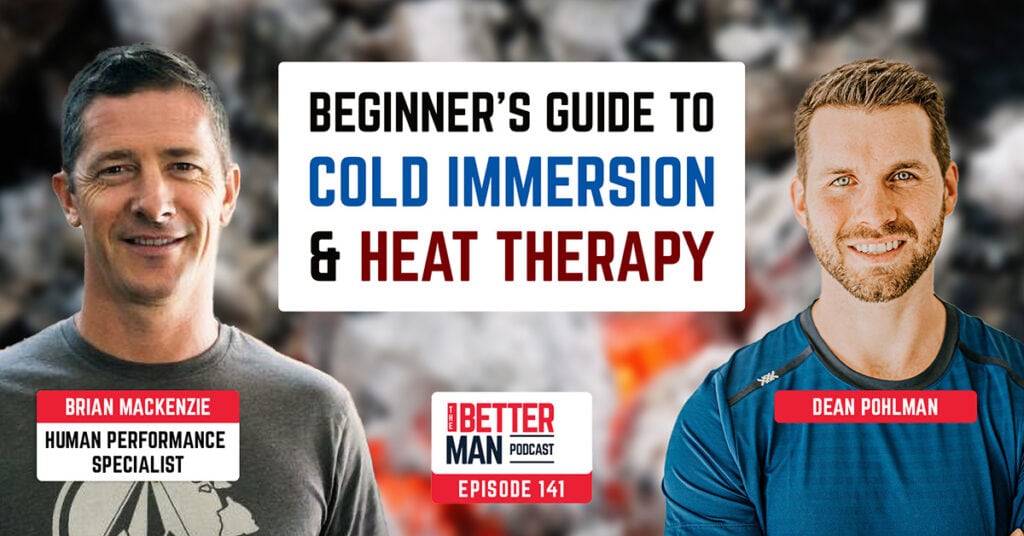

Beginner’s Guide to Cold Immersion & Heat Therapy | Brian Mackenzie (Human Performance Specialist) | Better Man Podcast Ep. 141
Figuring out which alternative therapies to fit into your already busy day, if any at all, can be overwhelming and confusing….
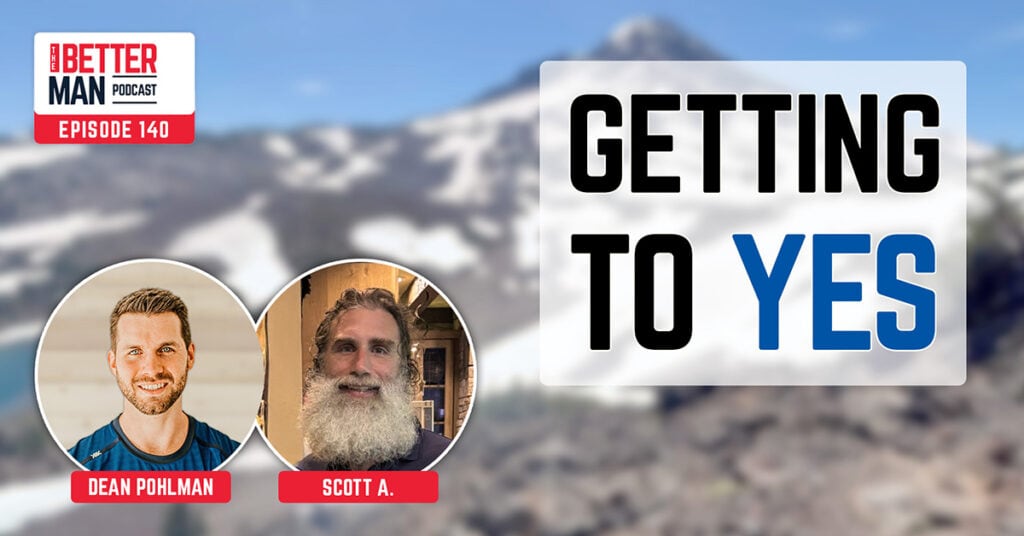

Getting To Yes | Scott A. | Better Man Podcast Ep. 140
Today’s guest, Man Flow Yoga Member Andy, is also a physical therapist who was cursed with genetic bad luck:
His family has…
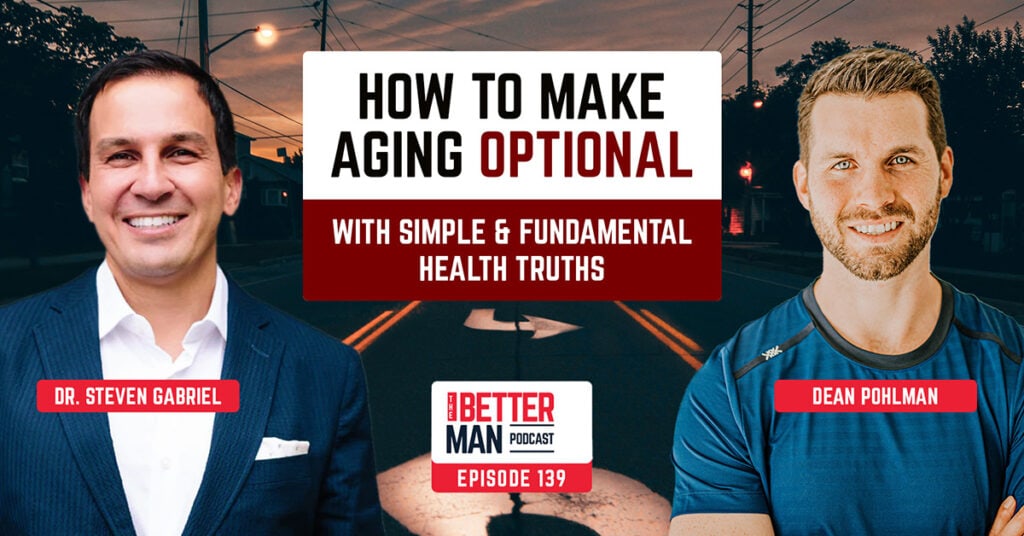

How to Make Aging Optional with Simple & Fundamental Health Truths | Dr. Steven Gabriel | Better Man Podcast Ep. 139
All humans have a psychological glitch that’s detrimental to your health. It speeds up aging, makes the number on your scale…
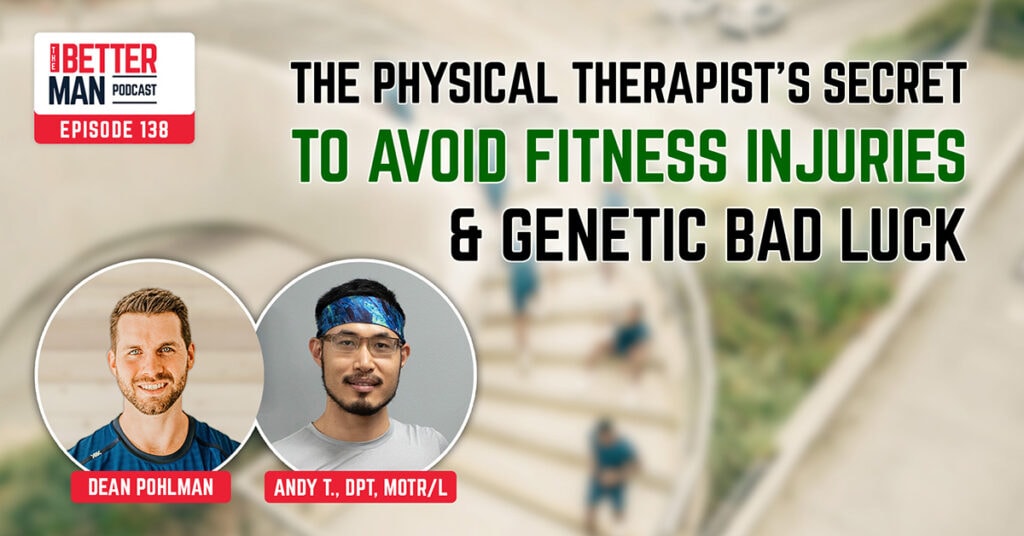

The Physical Therapist’s Secret to Avoid Fitness Injuries & Genetic Bad Luck | Andy T., DPT, MOTR/L | Better Man Podcast Ep. 138
Today’s guest, Man Flow Yoga Member Andy, is also a physical therapist who was cursed with genetic bad luck:
His family has…
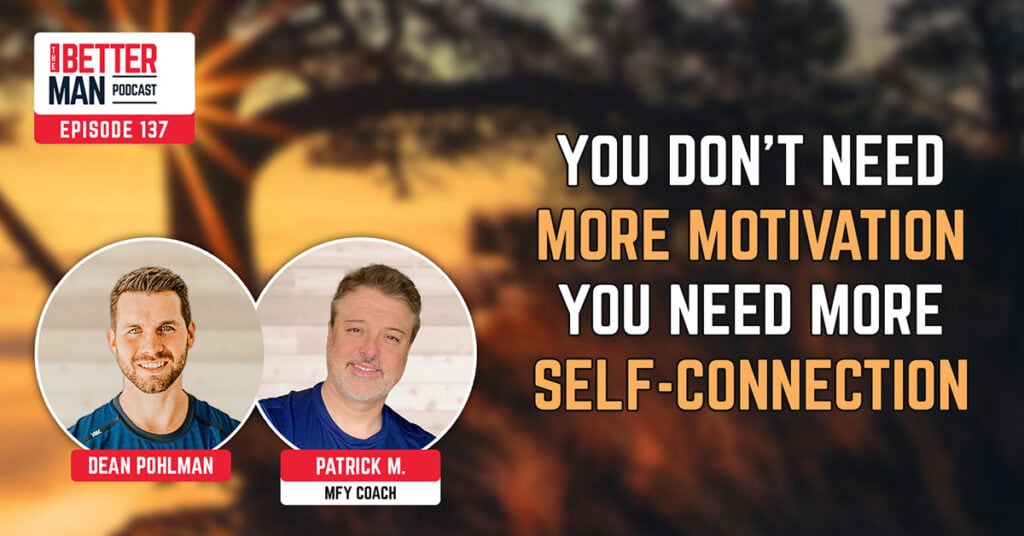

You Don’t Need More Motivation, You Need More Self-Connection | Patrick M. (MFY Coach) | Better Man Podcast Ep. 137
External motivation is a tricky and fickle thing that can make you consistent one week, only to feel defeated and deflated…
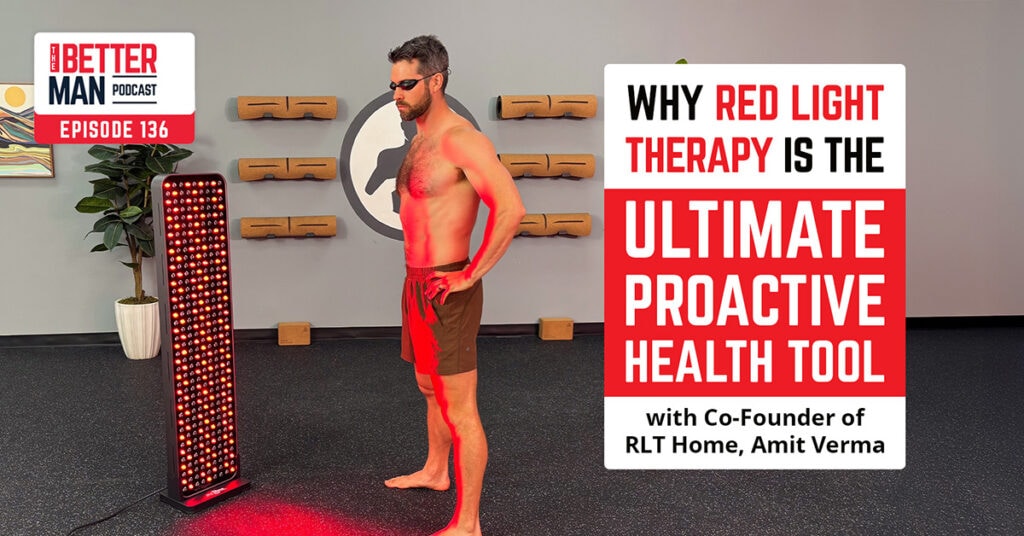

Why Red Light Therapy is the Ultimate Proactive Health Tool with Co-Founder of RLT Home, Amit Verma | Better Man Podcast Ep. 136
Red light therapy has been scientifically verified to help against at least 500 health conditions… and this number keeps steadily growing…
